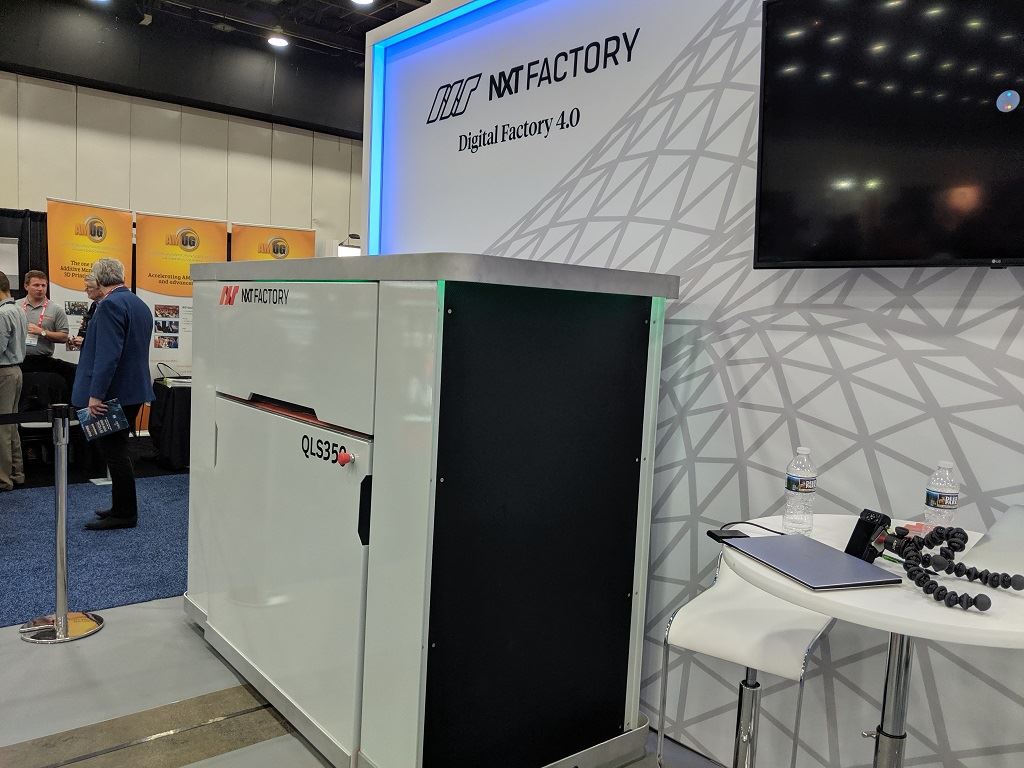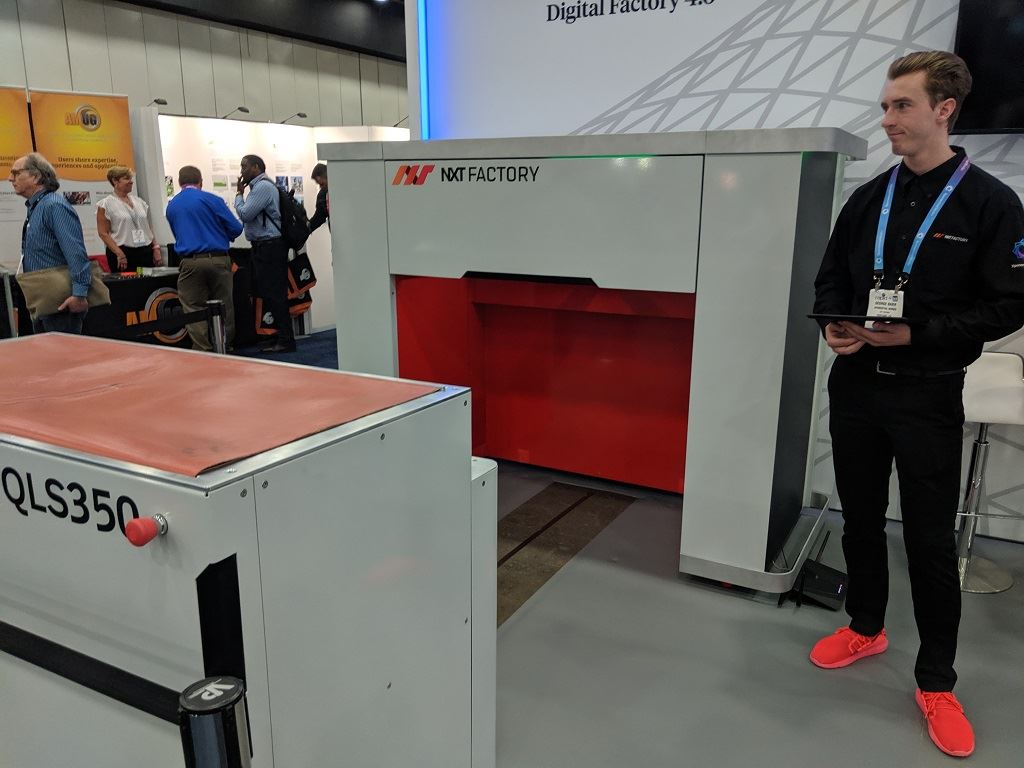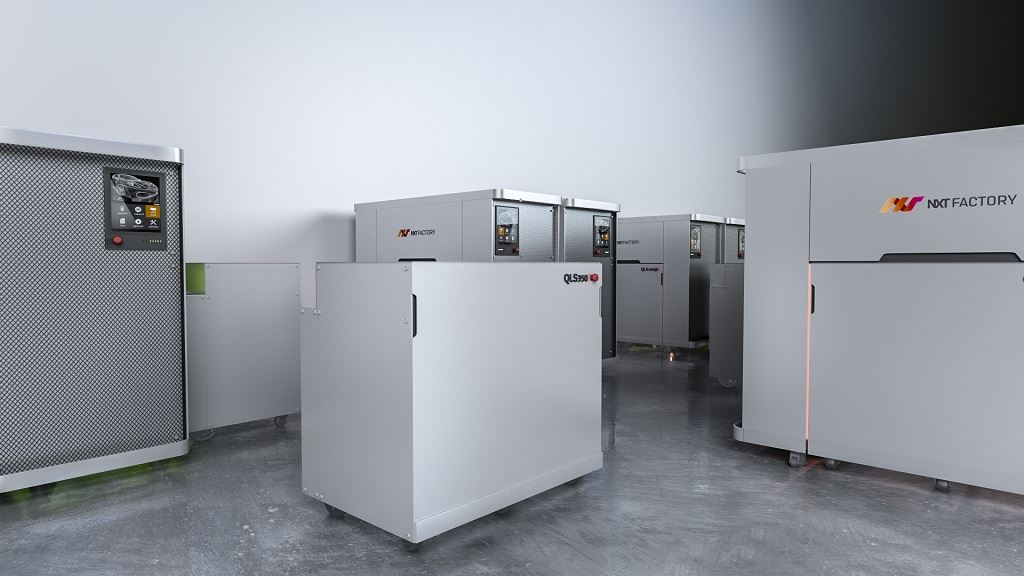![A QLS 350 installation rendering [Image: NXT Factory]](https://fabbaloo.com/wp-content/uploads/2020/05/QLS350-1last1_img_5eb093895f89a.jpg)
SLS 3D printing is getting smarter with NXT Factory.
During my recent visit to Ventura, California to see the operations of XponentialWorks portfolio companies first-hand, I appreciated the opportunity to learn more about NXT Factory.
CEO Jakub (Kuba) Graczyk, CTO Tomasz Cieszyński, and Executive Chairman Avi Reichental shared a look into what’s to come.
A Fully Automated System
Seeking to develop the next step for SLS technology, the NXT team created Quantum Laser Sintering (QLS). Its first system, the QLS 350, made its public debut this spring at RAPID + TCT.
There, I had a look at the automated movement of the build unit in and out of the printer:


It’s an interesting time now for the company, which is in a “transition from early prototype to final validation, as we want to deliver by the end of September,” as Graczyk noted.
The QLS 350 is among the new systems entering the market with a firm focus on production. It is designed to be a high-speed, high-temperature, high-performance polymer system. The fully automated system, Graczyk continued, takes “an approach no one has done yet.”
“How we envision the system is this: I used to work in extrusion, where boring is good, and we want that same approach — for two, three, four machines, using ten, eleven, twelve carts… We want it to be a part of the factory along with other techniques like injection molding. There are certain manufacturing volumes we are aiming for, and we believe low-to-medium-volume is within reach,” he said.
The system has been developed over the last three years and is nearing market readiness now. It features a robotically guided exchangeable powder cart, integrated thermal management, and multiple sensors, along with a cloud-based production management system.
NXT Factory says the system “produces up to 4X the print speed of traditional laser sintering technologies and is on par with the print speed of multi-jet fusion printers thanks to its proprietary beam delivery system and overall autonomous powder management.” They have been receiving orders to test powders that need temperatures up to 230C, Graczyk noted.
Go-To-Market
Next up for the QLS 350 is final validation and delivery.
Shipments are expected to begin in September, and by the end of this year NXT Factory hopes to deliver some 15-20 beta/early systems: “That means running nonstop through the end of the year,” Reichental noted.
The first installations will likely be set for fellow XponentialWorks portfolio company Techniplas, which has had real interest in the QLS 350. They are not alone, though; as Reichental said, “the speed, automation, and high-temperature SLS at about a $200,000 base offering is generating a lot of interest.” But, he added cautiously, “It doesn’t matter how excited we are; when it comes to early users and resellers, it’s about what they see, not what we see.”
One are of particular interest has been with service bureaus, thanks to the automation capabilities.
“A service bureau wanted a system for use with four-shift operations that require one shift of labor, because the machines operate by themselves then,” Graczyk said.
The potential users NXT Factory is talking with now are “serious users who live and breathe in the manufacturing world,” Reichental added. “They get much more excited about greater automation, online monitoring and control, post-processing automation — more about these aspects than the details of 3D printing.” The excitement over these aspects underscores the team’s intent to place the QLS 350 in manufacturing environments alongside traditional technologies.
“This opened our eyes to the fact that it’s not just about 3D printing technologies. They may not create headlines or turn heads, but offer a more attractive path to customers who won’t be wowed just by technology,” Reichental said. “They can crawl into the machine and in five minutes tell us what makes us work, and they congratulate us for it, but that isn’t what they get excited about. These are meaningful aspects, such as Siemens-powered depowdering and more automation, that are the less sexy but tangible nuggets that will make this more marketable.”
Next NXT Steps
![Avi (left) and Kuba discuss NXT Factory progress in Ventura [Image: Fabbaloo]](https://fabbaloo.com/wp-content/uploads/2020/05/nxtfactoryventura1_img_5eb0938a80fcf.jpg)
Through the end of this year, Graczyk said, the goal is to get strong validation on the QLS 350 from beta users and follow up with early adopters.
“We are a little in stealth right now and are not pushing,” he said. “We want to have it all done once, and done right, we want to operate efficiently and know that before we are fully shipping.”
In the near future, that means installations with four or five beta users working in different verticals, such as Techniplas in automotive, and continuing on with material development. Three key verticals for NXT Factory are automotive, service bureaus, and consumer goods; they may also see use in aerospace.
Over the next two months, beta feedback will help the team tweak and ready for the next step, in which they will add about ten early adopters to the installed base. For 2020, the plan is to really ramp up and scale production efforts to deliver more systems.
The QLS 350 is completely made in Ventura — “We want to be a Made in the US company,” Graczyk said — with all IP secured in the US.
As progress continues, the company will itself scale up as well. With about eight employees now, the plan is to double in size. Operations include five engineers in Kraków, Poland, where Graczyk and Cieszyński began the NXT journey, and that site should see a scale up as well. By the end of 2020, the company anticipates about 40-45 people on the team, including sales — though the plan includes working with distributors and resellers, NXT plans to keep key accounts in-house, working with the expertise of XponentialWorks’ CRO, Michele Marchesan, on that side of sales.
We caught up as well about NXT Factory’s “long horizon” view and additional technologies in development — suffice to say, for now, that the company has quite a long game plan in place.
Taking SLS 3D printing more fully into production through a combination of legacy know-how and innovative development, NXT Factory is well situated indeed to see great interest as its first release nears market readiness.
Via NXT Factory











A blog post reveals much of what happens behind the scenes at 3D print service Shapeways.